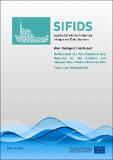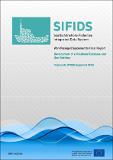Files in this item
Scottish Inshore Fisheries Integrated Data System (SIFIDS): work package 6 final report development of a pilot relational data resource for the collation and interpretation of inshore fisheries data
Item metadata
| dc.contributor.author | Tidd, Alexander N. | |
| dc.contributor.author | Ayers, Richard A. | |
| dc.contributor.author | Course, Grant P. | |
| dc.contributor.author | Pasco, Guy R. | |
| dc.contributor.editor | James, Mark | |
| dc.contributor.editor | Ladd-Jones, Hannah | |
| dc.coverage.spatial | 52 | en_US |
| dc.date.accessioned | 2021-06-30T10:36:41Z | |
| dc.date.available | 2021-06-30T10:36:41Z | |
| dc.date.issued | 2019 | |
| dc.identifier.citation | Tidd, A. N., Ayers, R. A., Course, G. P., Pasco, G. R., James, M. (Ed.), & Ladd-Jones, H. (Ed.) (2019). Scottish Inshore Fisheries Integrated Data System (SIFIDS): work package 6 final report development of a pilot relational data resource for the collation and interpretation of inshore fisheries data. Published by Marine Alliance for Science and Technology for Scotland (MASTS). 52pp. | en_US |
| dc.identifier.uri | https://hdl.handle.net/10023/23452 | |
| dc.description.abstract | [Extract from Executive Summary] The competition for space from competing sectors in the coastal waters of Scotland has never been greater and thus there is a growing a need for interactive seascape planning tools that encompass all marine activities. Similarly, the need to gather data to inform decision makers, especially in the fishing industry, has become essential to provide advice on the economic impact on fishing fleets both in terms of alternative conservation measures (e.g. effort limitations, temporal and spatial closures) as well as the overlap with other activities, thereby allowing stakeholders to derive a preferred option. The SIFIDS project was conceived to allow the different relevant data sources to be identified and to allow these data to be collated in one place, rather than as isolated data sets with multiple data owners. The online interactive tool developed as part of the project (Work Package 6) brought together relevant data sets and developed data storage facilities and a user interface to allow various types of user to view and interrogate the data. Some of these data sets were obtained as static layers which could sit as background data e.g. substrate type, UK fishing limits; whilst other data came directly from electronic monitoring systems developed as part of the SIFIDS project. The main non-static data source was Work Package 2, which was collecting data from a sample of volunteer inshore fishing vessels (<12m). This included data on location; time; vessel speed; count, time and position of deployment of strings of creels (or as fleets and pots as they are also known respectively); and a count of how many creels were hauled on these strings. The interactive online tool allowed all the above data to be collated in a specially designed database and displayed in near real time on the web-based application. | en_US |
| dc.language.iso | en | en_US |
| dc.publisher | Marine Alliance for Science and Technology for Scotland (MASTS) | en_US |
| dc.rights | Copyright © the author(s) / rights holder. This is the final version of the work. This work has been made available online with permission. Permission for further reuse of this content should be sought from the rights holder as identified in the PDF. | en_US |
| dc.subject.lcsh | Fisheries--Research | en_US |
| dc.subject.lcsh | Marine biology | en_US |
| dc.subject.lcsh | Oceanography | en_US |
| dc.subject.lcsh | Marine biology--Scotland | en_US |
| dc.title | Scottish Inshore Fisheries Integrated Data System (SIFIDS): work package 6 final report development of a pilot relational data resource for the collation and interpretation of inshore fisheries data | en_US |
| dc.type | Report | en_US |
| dc.description.version | https://doi.org/Publisher PDF | en_US |
| dc.publicationstatus | Published | en_US |
| dc.status | Non peer reviewed | en_US |
| dc.identifier.doi | https://doi.org/10.15664/10023.23452 | en |
This item appears in the following Collection(s)
Items in the St Andrews Research Repository are protected by copyright, with all rights reserved, unless otherwise indicated.


